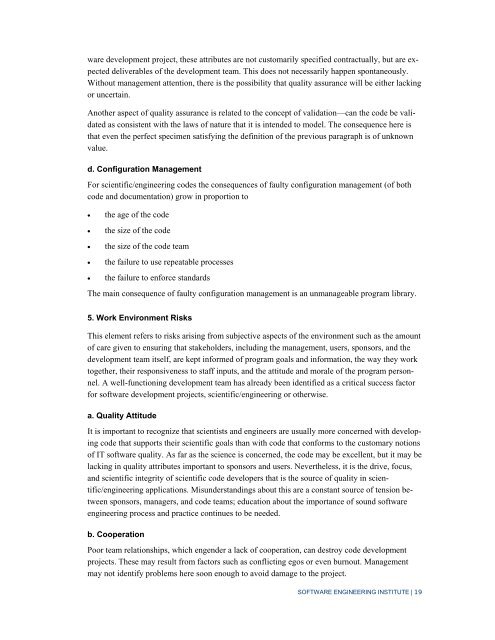A Proposed Taxonomy for Software Development Risks for High ...
A Proposed Taxonomy for Software Development Risks for High ...
A Proposed Taxonomy for Software Development Risks for High ...
You also want an ePaper? Increase the reach of your titles
YUMPU automatically turns print PDFs into web optimized ePapers that Google loves.
ware development project, these attributes are not customarily specified contractually, but are expected<br />
deliverables of the development team. This does not necessarily happen spontaneously.<br />
Without management attention, there is the possibility that quality assurance will be either lacking<br />
or uncertain.<br />
Another aspect of quality assurance is related to the concept of validation—can the code be validated<br />
as consistent with the laws of nature that it is intended to model. The consequence here is<br />
that even the perfect specimen satisfying the definition of the previous paragraph is of unknown<br />
value.<br />
d. Configuration Management<br />
For scientific/engineering codes the consequences of faulty configuration management (of both<br />
code and documentation) grow in proportion to<br />
• the age of the code<br />
• the size of the code<br />
• the size of the code team<br />
• the failure to use repeatable processes<br />
• the failure to en<strong>for</strong>ce standards<br />
The main consequence of faulty configuration management is an unmanageable program library.<br />
5. Work Environment <strong>Risks</strong><br />
This element refers to risks arising from subjective aspects of the environment such as the amount<br />
of care given to ensuring that stakeholders, including the management, users, sponsors, and the<br />
development team itself, are kept in<strong>for</strong>med of program goals and in<strong>for</strong>mation, the way they work<br />
together, their responsiveness to staff inputs, and the attitude and morale of the program personnel.<br />
A well-functioning development team has already been identified as a critical success factor<br />
<strong>for</strong> software development projects, scientific/engineering or otherwise.<br />
a. Quality Attitude<br />
It is important to recognize that scientists and engineers are usually more concerned with developing<br />
code that supports their scientific goals than with code that con<strong>for</strong>ms to the customary notions<br />
of IT software quality. As far as the science is concerned, the code may be excellent, but it may be<br />
lacking in quality attributes important to sponsors and users. Nevertheless, it is the drive, focus,<br />
and scientific integrity of scientific code developers that is the source of quality in scientific/engineering<br />
applications. Misunderstandings about this are a constant source of tension between<br />
sponsors, managers, and code teams; education about the importance of sound software<br />
engineering process and practice continues to be needed.<br />
b. Cooperation<br />
Poor team relationships, which engender a lack of cooperation, can destroy code development<br />
projects. These may result from factors such as conflicting egos or even burnout. Management<br />
may not identify problems here soon enough to avoid damage to the project.<br />
SOFTWARE ENGINEERING INSTITUTE | 19
















